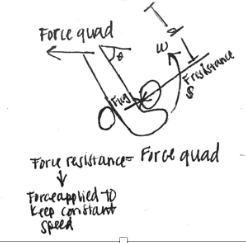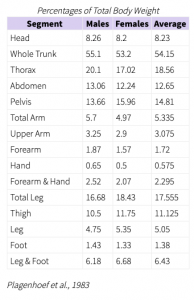Isokinetic Dynamometry Engineering Problem:
An 18-year-old, 5’4”, 130 lbs female soccer player is just recovering from an ACL tear and wants to know if she can get back in the game. She has been super cautious and tentative to rehab strength exercising routines, so she is sure she is ready, but wants to quantify her strength. To do this, she decides to measure her quadricep and hamstring strength on an isokinetic dynamometer and evaluate her hamstring to quad ratio, which should be between 50 and 80 percent [1]. Other important values include power, work, and peak force to assess the muscle and plan for future rehab exercise routines.
Based on previous studies, to test for power and strength of a muscle, the optimal speed is 60º/sec [2]. She also performs the test with a range of 0-90 º. The results of her hamstring force came back as 54.663 lbs and her recorded quadricep torque value determined by the isokinetic dynamometer is 102.45 lbs*ft3. The patient also wants to know her kick velocity (for fun). The computer is not properly calculating important values, and hand calculations must be performed to ensure accuracy. Calculate the power, work, and force of the quadricep, the angular speed at which the leg kicks, and the hamstring to quadricep ratio to determine if the patient can go back to playing.
*See attached anthropometric weight and measurement documents to determine distance and mass
Solution:
Assumptions: To simplify the math, we are ignoring the effects of gravity and inertia from the swinging limb. In real life, they play a major part in the force read by the machine and there are algorithms the computer goes through to factor out the effects. Also, the math that is performed based on the free body diagram is the forces on the knee joint, not just the quadricep. There are many forces that play a part, but for simplicity reasons we will treat them as only the force produced by the quadricep. Furthermore, there are other considerations when thinking about ACL recovery such as muscle strength and also whether or not the muscles are even. In this problem, we only look at one muscle and do not do a comparison.
1.Since Torque is given (102.45 lbs*ft), Force can be found by
Torque=〖Force〗_quad x d or 〖Force〗_quad*d_perpendicular
First: find perpendicular distance, which will be the length from the patient’s knee to ankle (d on free body diagram)
From the anthropometric table, the distance is Height*(0.285-0.039), where H= 5.33 ft.
Therefore. d=1.312 ft
102.45 lb*ft=〖Force〗_quad*1.312ft
〖Force〗_quad=78.09 lbs
2.Now that Force of the quadricep is found, we can solve for work
The distance, in this case, is the distance the leg travels, which will be the arch distance
s (arch distance)=rθ
r in this case is equal to d. Also, the range (θ) is 90 º, which in radians is 1.571 (90*(π/180))
s=(1.312)(1.571)= 2.06 ft
Now that we have d, multiply by force to get work
Work=78.09 lbs*2.06 ft=160.96 ft*lbs
3.Power can be solved by using the equation
Power=torque*angular velocity
Angular velocity is 60º/sec, which in radians (multiplied by (π/180)) is 1.047 s-1
Plugging in,
Power=102.45lb*ft*1.047 s^(-1)=107.28 (ft*lb)/sec
4.To find angular velocity (ω) her leg is going, the angular acceleration must be determined based off of the force exerted by the quadricep
The following equations must be used
F=m_lowerleg*a_n
a_n=ω^2 r,where r=d
*Note: Since there is a circular motion, angular acceleration must be assessed. Since there is a constant velocity, there is no at component.
Using the weight chart, you should find the weight of the lower leg is 0.0618*weight, which in this case is
(0.0618*130 lbs)/(32.2 )=0.2495 s
Therefore:
78.09 lbs=0.2495 slugs* ω^2*1.047 ft
ω^2=298.7 rads/sec
ω=17.28 rads/sec (times 180/π to get degrees)
ω= 990.2 º/sec
5.Finally, to find hamstring to quadricep ratio
Ratio=(Hamstring Force)/(Quadricep Force) x100
Ratio=54.663/78.09 x100=70%
Therefore, it can be concluded the patient can return back to the field
Overall
Force (quad) = 78.09 lbs
Work=160.96 ft*lbs
Power=107.3 ft*lbs/sec
Angular Velocity = 990.2 º/sec
Hamstring/Quad ratio = 70%
All of these values make physiological sense and line up with average results from other research[3,4]
Tables
Figure 1: Mean Segment data taken from https://exrx.net/Kinesiology/Segments
Figure 2: Anthropometric data showing body segment length as a function of total height. From Winter, D.A., Biomechanics and Motor Control of Human Movement, Wiley Interscience, New York, 1990
Sources:
- Rosene, J., Fogarty, T., & Mahaffey, B. (201). Isokinetic Hamstrings:Quadriceps Ratios in Intercollegiate Athletes. Journal of Athletic Training,36(4), 378-383. Retrieved from https://www.ncbi.nlm.nih.gov/pmc/articles/PMC155432/pdf/attr_36_04_0378.pdf.
- Duarte, J. P., Valente-Dos-Santos, J., Coelho-E-Silva, M. J., Couto, P., Costa, D., Martinho, D., … Gonçalves, R. S. (2018). Reproducibility of isokinetic strength assessment of knee muscle actions in adult athletes: Torques and antagonist-agonist ratios derived at the same angle position. PloS one, 13(8), e0202261. doi:10.1371/journal.pone.0202261
- Holmes, & Alderink. (1984). Isokinetic Strength Characteristics of the Quadriceps Femoris and Hamstring Muscles in High School Students. Physical Therapy,64, 914-918. Retrieved from http://citeseerx.ist.psu.edu/viewdoc/download?doi=10.1.1.1016.6759&rep=rep1&type=pdf
- Heyward, V.H. (2010) Advanced fitness assessment and exercise prescription (6th Ed.) Champaign IL: Human Kinetics




What a neat problem! Interesting technology and utilization of biomedical measurements to rehabilitation applications.